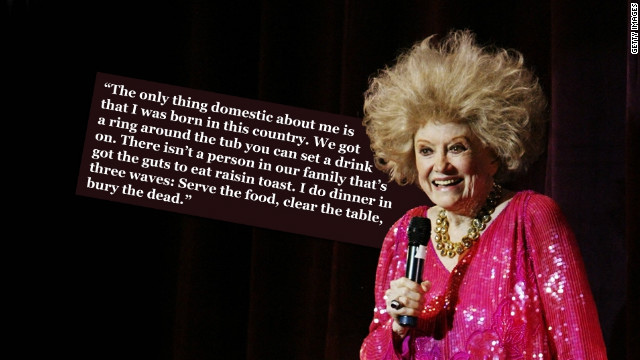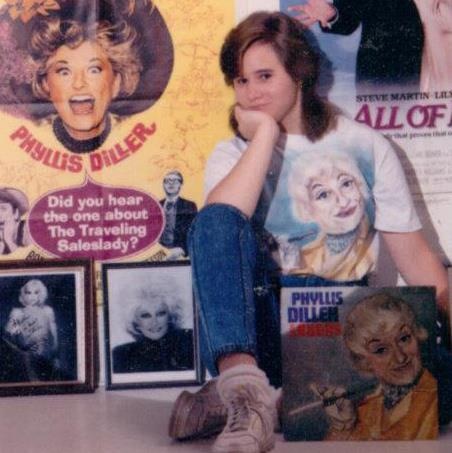The Face (and Laugh) that Launched a Thousand Bits
I was very pleased when contacted to write a post in honor of the passing of Phyllis Diller. In grade school, I stumbled upon the 1962 Phyllis Diller album, Phyllis Diller Laughs. Although I already knew Diller from her Scooby Doo episode and Gong Show appearances, my burgeoning “unruly woman” (props to Kathleen Rowe) found her recorded irreverence, visual chaos, and uncontrolled laughter intoxicating. In the early eighties, an age of sexualized teenage gross-out romcoms, a pixie-ish post-SNL Gilda Radner, and the fleeting hopes for an Equal Right Amendment, Diller’s comedy provided me an unhinged and complicated vision of American femininity. She both reflected the cultural primacy of marriage, motherhood, and feminine appearance a growing Midwestern girl was absorbing by osmosis, and rejected the notion that women—and perhaps I—must just sit back and accept it. At age 10 I was hooked and integrating Diller bits into grade school puppet shows. At 15 I saw her live in a St. Louis area club, was rendered speechless when I wheedled my way backstage to meet her, and (as a birthday gift) procured a most awesome airbrushed Phyllis Diller t-shirt. By 20 I had most of her albums, books, etc., including a recording of her singing The Rolling Stones’ “Satisfaction.” Now, at 40, I revisit my love for Diller and realize that for many, Phyllis had become synonymous with Kelly Kessler (based on the Facebook condolences I received from folks met over the past 30 years). I can think of much worse folks and things to which I could be linked.
What was it about Diller that entranced me? Although 55 years earlier, she too was born into a traditional Midwestern existence. Born in Lima, Ohio (perhaps the original “Lima Loser” for Glee fans) in 1917, by 22 she had achieved her “destiny” and married her first husband, Sherwood Diller. Her destiny would change. In the early to mid 1950s, she honed her stand-up act in the clubs of San Francisco and St. Louis. She was truly the mother of stand-up comediennes, a group largely nonexistent prior to Diller’s club tenure. (I’ve always said that Diller, Lily Tomlin, and Joan Rivers are the pyramid of female comedic power.) Although preceded by female comedic entertainers and quasi-stand-ups like Belle Barth, Martha Raye, and Moms Mabley, Diller entrenched herself in the male realm of the night club.
In the era of Lenny Bruce’s obscenity trials and two years prior to the release of Betty Friedan’s The Feminine Mystique, Diller’s first album (the one I found in 1980)—and overall act—reconfigured the terms “funny” and “women.” Phyllis Diller Laughs flaunted her poor housekeeping skills, disdain for her amalgam of a husband “Fang,” and her less-than-good looks. If the audience was going to laugh at her figure, she was going to call the shots. With fright wigs, colorful and gaudy clothing, and a freakishly long cigarette holder, she joked about her concave breasts and lack of sex appeal. She would continue performing a version of her act into the new millennium, featured in the documentary Good Night, We Love You (2004).
Why does any of this matter? Diller’s fingerprints are all over the last half century of female performers: Joan Rivers (Diller’s kindred spirit in plastic surgery), Bette Midler, Roseanne, Brett Butler, Rita Rudner, Diane Ford, Sandra Bernhard, Sarah Silverman, Kathy Griffin, and the list goes on. Diller’s comedy, while surely self-deprecating, questioned the equation of funny women with hyper-sexuality and/or air-headedness (e.g. the amazing Gracie Allen, Goldie Hawn, etc.). Her act, while still reliant on a recognition of social gendered norms, was smart, sassy, and rebellious. While many comediennes’ acts turned bluer than Diller’s, one cannot deny her trailblazing power. Her successful leap into the male world of stand-up paved the way for a never-ending crop of funny women, unfettered (okay, less fettered) by the stigma of comedic masculinization or dimwittedness.
Since her passing, I have been repeatedly struck by two bits from my first Diller album. In it she stated two desires: (1) She wanted to be a sweet little old lady, “with a cane full of gin” and (2) She really wanted to live to be 100. She felt at that point she could look people straight in the eye and say “I’m pooped.” Well, at 95 she just fell shy of the latter desire; however, a half century of comedy surely provided her the right to officially be pooped. Wherever she is, I hope her cane full of gin is self-replenishing. In closing, thanks for helping to form this once aspiring comic, now gender scholar, and forever hopeless fan. May her piercing and wild laugh further lighten the great beyond.





Just lovely, Kelly, lovely. The words and your picture. 🙂
Kelly, This reminds me (not that I needed the reminder) of how I have always been impressed with you and why I love that we are friends. I do seem to recall many years ago, saying to you that you should not be an actress, but a stand-up comic. I repeat this suggestion (as perhaps a part-time hobby in addition to being a professor and mom!) because I feel you embody Ms. Diller’s spirit!
Thanks for your information and tribute to Phyllis Diller. She was truly a trailblazer for commediennes and all women alike.